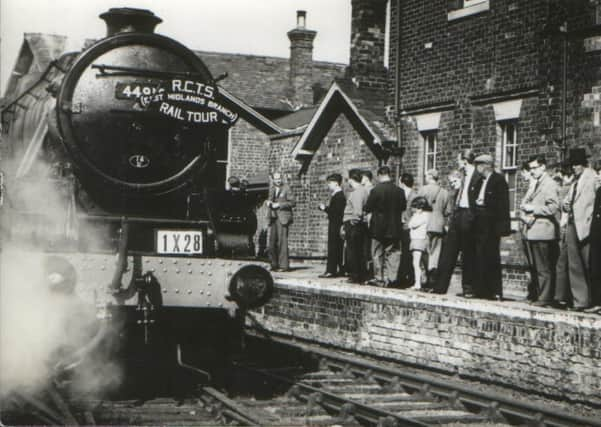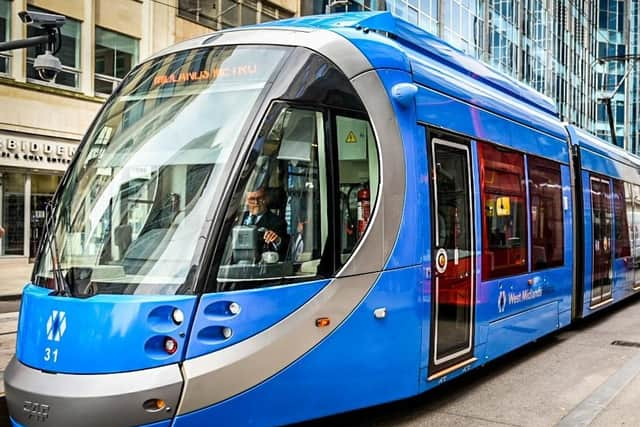Are the signals all set for a return of our ‘lost’ railways?


Far fetched it might sound, looking at the way centres such as Woodhall Spa and Louth have been built over where the rails once ran, or where busy roads such as the A16 have colonised disused lines ,to replace steel and sleepers with tarmac and roundabouts.
It’s not actually quite as far fetched as it may sound, with the Government recently announcing it is investing £794m in reopening two lines lost to the infamous Beeching Cuts in the 1960s.
Advertisement
Hide AdAdvertisement
Hide AdAnd the Government is funding a feasibility study into reopening services on a route in the north of Lincolnshire: Barton-on-Humber to Brigg, Kirton Lindsey and Gainsborough Central.


It’s all part of a project called “Restoring Your Railways Fund”.
Could it help put much of Lincolnshire back on the rails?
Back in 1952, when closure of the branch line from Woodhall Junction to Woodhall Spa and Horncastle was first proposed, British Railways was experimenting with a Great Western diesel rail car around Boston and Louth, to see what would be needed to replace steam trains in East Lincolnshire and thus reduce costs, journey times, crewing and pollution.
The experiments and research into possible benefits for Horncastle and Woodhall Spa delayed the closure of the line to passengers until September 1954 (it finally closed 50 years ago to goods trains), but the experiments led to many of Lincolnshire’s lines being served by modern diesel multiple units, which cut operating costs and provided passengers with a cleaner ride than the steam trains.
Advertisement
Hide AdAdvertisement
Hide AdThey also gave spectacular views not only over the surrounding countryside but forward, through the driver’s cab, of the tracks and signals.
Their successors provide useful service on surviving lines in the county today, including two stations which have already been reopened, Metheringham and Ruskington.
There’s a danger, though, of seeing the lost lines through rose tinted spectacles.
Most had village stations long distances from the communities they purported to serve; a vast number of antiquated level crossings, signalling system and traffic was declining in the face of road competition.
Advertisement
Hide AdAdvertisement
Hide AdThis made them expensive to operate and the prospect of a worthwhile return on any investment unlikely.
Lincolnshire was in economic decline by the time Dr Beeching recommended swinging his axe over most. Cheap package holidays to Spain were cutting into seasonal traffic to Skegness, Mablethorpe and Cleethorpes.
At Woodhall Junction there was an inconvenient and time consuming junction between the Horncastle branch and the lines to Lincoln, Boston and via Coningsby to Firsby (for Skegness and East Lincs).
The line to Boston from Woodhall Junction closed in 1963, eliminating any potential for a revived service from Horncastle to Woodhall Spa, Boston and Peterborough (for London).
Advertisement
Hide AdAdvertisement
Hide AdEast Lincolnshire lost most passenger services in 1970 (except Skegness - Boston- Grantham).
Would traffic from Horncastle have justified retention of the closed lines?
The closure of the main East Lincolnshire line from Grimsby to Peterborough, through Louth, Alford, Boston and Spalding was a body blow for those communities, when trains stopped running in October 1970 – including the buffet car expresses which offered a seamless journey into Kings Cross in around three hours.
The loop line from Louth to Mablethorpe and Sutton on Sea had closed in 1960, making inevitable the closure of the section through Sutton on Sea to the junction at Willoughby .
Advertisement
Hide AdAdvertisement
Hide AdThe entire Midland & Great Northern system in the south of the county was closed in 1959,ending through services as far west as Birmingham and Gloucester and eastwards to Norwich, Sheringham and Great Yarmouth (it was seen as an experiment to gauge the political backlash from what was then the largest system closure ).
Conservative voting territory and the Government of the day realised they could close many other lines with equal impunity.
The routes from Lincoln to Grantham, Chesterfield and East Anglia (beyond Spalding to March) as well as Immingham’s passenger services, all followed, some before Dr Beeching’s report.
Already the branch line for Spilsby had lost it passenger service at the outbreak of World War Two and its freight trains ceased in 1958. The line was busy, but a bridge needed replacing and the cost would have outweighed any financial return.
Advertisement
Hide AdAdvertisement
Hide AdThe Louth to Bardney line, meandering through the most beautiful part of the Wolds via Hallington, Withcall, Donington- on-Bain, Kingthorpe and Wragby, lost its sparse (too sparse to be of much use) passenger service in 1951 and the goods services closed in sections up to 1960.
While railways are now seen as a convenient, eco-friendly way of moving people and freight, when these closures took place, they were perceived to be antiquated, encumbered by difficult relations with trade unions and in need of substantial subsidies to stem ever-increasing financial losses, it would have taken a brave and visionary decision by Government to develop Horncastle’s passenger trains at the time, though the East Lincolnshire main line closures of 1970 took place as opinions were changing.
Subsidy schemes were being developed, fewer closures were being authorised, and today a closure on such a scale would be unthinkable – even in the face of losses caused by Covid and travel restrictions.
Freight? While much of what came into the Horncastle branch (agricultural oil, feedstuffs, fertiliser, agricultural machinery, tyres) was suitable for more modern wagon load traffic, containerisation and block load trains were clearly the way ahead in the 1970s, as Dr Beeching had argued: little scope for a remote branch line to a small town to maintain and develop its rail freight service.
Advertisement
Hide AdAdvertisement
Hide AdThe same applied for much of mid-Lincolnshire. Freight continued to Louth until the early 1980s; freight services continue to Boston Docks carrying steel; multiple millions have been invested in the surviving Doncaster – Gainsborough Lincoln Sleaford route to take lengthy container and oil trains away from the East Coast Main Line, via Spalding to and from Peterborough.
In the north of the county, the lines through Barnetby to the docks at Immingham carry around a quarter of the UK’s rail freight traffic.
But, will we ever be able to board a train again at one of Lincolnshire’s lost stations and head to the rest of the country or connect into Eurostar via London ?
Maybe it is not so far fetched in some cases. The Government clearly sees wider economic and social benefits from railways than it did at the time of Dr Beeching – who, love him or loathe him, did what he was asked to do and his plans were carried out by both Conservative and Labour Governments.
Advertisement
Hide AdAdvertisement
Hide AdIn justifying the £760 millions to rebuild and reopen the East West Line from Oxford to Cambridge (already reopened from Oxford to Bicester) it is said the investment will reconnect communities and stimulate economic growth, creating 1,500 skilled jobs
The £794 million investment package to reopen the rail routes closed more than 50 years ago was announced on 23 January 2021 by Transport Secretary Grant Shapps.
It also includes £34 m to rapidly progress plans to reopen the Northumberland line between Newcastle-upon-Tyne and Ashington, which closed to passengers in 1964 as part of the Beeching cuts.
The Transport Secretary called on local authorities, and community groups to submit bids for a share of the third and final round of the Department for Transport’s Ideas Fund,designed to encourage proposals to reopen railway lines, services and stations.
Advertisement
Hide AdAdvertisement
Hide AdThe announcement was billed as forming part of the government’s commitments to build back better from the coronavirus pandemic and level up transport infrastructure across the country by investing in rail connections that will boost economic growth, unlock new housing, and create jobs and opportunity.
So, is reopening some of Lincolnshire’s routes just pie in the sky – or given that several had inconvenient junctions and have been built over, are new sections needed to make them more useful to the Lincolnshire of today – parkway stations on the outskirts of town (Louth, Horncastle, Boston to Spalding for example) or even light rail – Metro routes, which can run on roads where needed, as well as reserved track, (as in the West Midlands, Nottingham, Blackpool and Croydon), connecting existing heavy rail at Skegness, Lincoln and Grimsby to Louth, Mablethorpe, Ingoldmells and elsewhere?
Whether local MPs will take up the suggestion from the Transport Secretary in conjunction with Lincolnshire’s county and district councils (as has happened with the planned revival of the Barton – Brigg – Gainsborough service) remains to be seen.
So maybe, it’s not an impossible dream to those of us stuck in traffic jams, breathing in fumes from trucks and buses, or even old enough to recall enjoying a meal while speeding through the Lincolnshire countryside on a direct train to London or Birmingham.
Advertisement
Hide AdAdvertisement
Hide AdThe Government says the latest round of the Ideas Fund will run until 5 March 2021, with successful bids due to be announced later this summer.
•Opinions expressed in this article by the author are his alone and are not meant to represent those of organisations of which he is a member